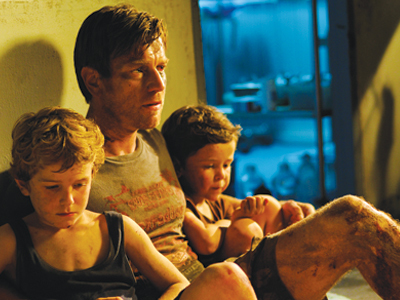By: debblie lynn elia
Ewan McGregor is no stranger to the challenges of bringing characters to life, be they based on real individuals or pure fantasy or, in finding the truth in a story or character and staying true to that truth. However, as Henry Belon in The Impossible, he was charged with a task more daunting than that which falls on a Jedi knight – staying true to the not only the essence of Henry Belon and his story and that of his family with the Christmas 2004 tsunami, but fulfill the emotional responsibilities of honoring all those affected by this horrific event.
Who doesn’t remember where they were or what they were doing on December 26, 2004, when a world-shattering tsunami arose in the Indian Ocean, decimating the entire region as it pummeled onto the shores of Thailand and elsewhere with such force so as to not only destroy land and property, but eradicate shipping lanes and reshape the underlying seabed. Slowly we saw video emerge of the devastation, at first from the cell phones and cameras of tourists celebrating the Christmas holidays in the lush tropical setting of Thailand. Slowly, we heard stories emerging describing the wall of water and debris, the fear, the panic, the search for loved ones in the aftermath. At the end of the day, the loss of life was unfathomable; the devastation too horrible to imagine. One family that survived the ordeal was the Belons – Henry, Maria and their three young sons, Lucas, Simon and Thomas. Reteaming with Naomi Watts who plays Maria Belon, Ewan McGregor is Henry – a man ripped from his family by the torrents of the tsunami, but never giving up hope that he would find them alive and be reunited. With a script by Sergio Sanchez based on the true experiences of the Belon family, director Juan Antonio Bayona floods us with emotion and horror, and joy, of reality with The Impossible.
During the Los Angeles leg of the press tour for The Impossible, I had a chance to talk to Ewan about the challenge of playing Henry Belon and capturing the emotional magnitude of this global disaster.
Always inherent in “The playing of a real person is a responsibility to him, for sure. I’ve done that before. But the difference in this situation is that. . .the family is a Spanish family and we have them as a British family, so already there was a distance between him and who I played, I felt. I wanted to play the essence, absolutely get him right. I found out a lot about his character and what he’s like. I spoke to him on the phone at some length because I didn’t have a chance to meet him before we started shooting. I knew that the writer had met him and knew him and obviously Sergio [Sanchez] wrote for weeks and weeks with Maria [Belon] who is married to him. So, I knew who he was and what kind of man he was. But I didn’t try to look like him. I had glasses like him, maybe. I didn’t try and become him physically. . .So, I felt like I had more freedom, if you like, with the character. However, when [the Belon family] visited – they came to Thailand after a month of shooting – suddenly I panicked. I thought, “Bugger, what’s he gonna think! Maybe I should have tried to be more like him” . . . [but] I was playing him. He’s on the page. He’s the character in the story. He’s the character in the script. And he’s the character the director knows.”
On meeting the real Henry, McGregor is reflective, noting, “[H]e told me that he had seen a photograph of us in the plane, of the opening of the film when we’re in the airplane and I’m sitting with my glasses. He saw this photograph and he told me he was showing his friends and going, ‘Look! He’s got me, but how did he do it! He doesn’t know me, he doesn’t know me!’ So, I was relieved he was happy. There’s that responsibility.”

But as McGregor himself avows,”[T]he much bigger and greater responsibility in this is to the tsunami itself, the people who were there, the people who died there and the people who lost their loved ones there, to the Thai people who live and support the tourist industry in that area. That’s a much greater responsibility and that’s the one that makes you nervous going in to do a film like this and always wary, I think, never to forget that responsibility. When you’re making a movie, especially something of this scale, it’s so complicated and the actual moviemaking process can become everything. You have to always remember to come back to the reality of what we’re doing. There would be moments when we set shots up and sometimes the shot would just feel like a big movie. There’s one shot where the camera swept over the devastation and there was a staircase that no longer led anywhere. I climbed the staircase and the camera’s sweeping in over the devastation and then up and then it cranes up into a big close-up and I shout, ‘MARIA!’ As we did it, I thought, ‘This doesn’t feel right.’ And I look in the monitor and I said, ‘I think it’s too heroic. It’s too much of a movie shot in a way.’ They didn’t use it. The true story had to always be at the heart of everything.”












